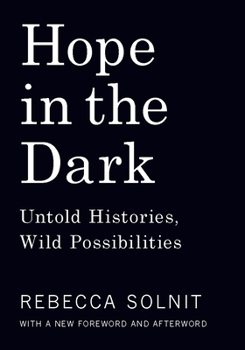Hope in the Dark: Untold Histories, Wild Possibilities
(Part of the Essays Series)
Select Format
Select Condition 
Book Overview
Bestselling author Rebecca Solnit reminds us that activism has changed the world in remarkable ways.
Format:Hardcover
Language:English
ISBN:1642591009
ISBN13:9781642591002
Release Date:September 2019
Publisher:Haymarket Books
Length:184 Pages
Weight:0.80 lbs.
Dimensions:0.6" x 5.8" x 8.3"
Customer Reviews
5 ratings
hope in the panoramic here and now
Published by Thriftbooks.com User , 17 years ago
Solnit reflects on a life of great hopes for the world, in an age of tragedies for humanity. She contemplates the experience of hope as it ranges from self-deception to simple honesty. Her stories expose small openings to unexpected possibilities, like making friends in a Eureka, Nevada bar with supporters of WRANGLERS (Western Ranchers Against No Good Leftist Environmentalist Radical S---heads), who share her hope for restoring the land. Her hope in final answers, correct ideologies or great leaders fades, but other possibilites arise moment by moment. She grows whimsically alert, noticing oddball blessings: "It turns out, for example, the Viagra is good for endangered species. Animal parts that traditional Chinese medicine prescribed as aphrodisiacs and for treating impotence -- including green turtles, seahorses, geckos, hooded and harp seals, and the velvet from the half-grown antlers of caribou -- are, thanks to the new drug, no longer in such demand. What more comic form of the mysterious unfolding of the world is there than this, which suggests that Viagra's ultimate purpose may be the survival of animals at the edges of the planet?" (p.77-78) Occasionally her activist life, her community, and all of world history come together in panoramas of bard-like awareness: "Take a third Pacific species, though -- the brown pelican, which also nearly disappeared then came back -- and imagine one pelican's trajectory from Ocean Beach, the western edge of my city and my own continent. Imagine it soaring with the heavy prehistoric grace of a pterodactyl down Fulton Street, the long street that starts at the beach, parallels the north side of Golden Gate Park, and carries on after the park ends to run east through the old African-American neighborhood, past surviving gospel churches and extict barbershops to the little formal garden between the War Memorial Building and the Opera House, then straight into City Hall, whose great guilded dome straddles the street. Let that pelican soar through the echoing central atrium where in 1961 students who protested the anticommunist purges were washed down the marble stairs with fire hoses, let the bird float out the other side, going on east, to United Nations Plaza, where Fulton dead-ends into Market Street, the city's main artery. This is the place where I stand in the present to face past and future, the place where stories come together, one of the countless centers of the world." (p.139-140)
Esperanza
Published by Thriftbooks.com User , 17 years ago
This book came to my attention via a Sonoma State colleague who uses it for her ecopsychology class. It is not intended to lay out a particular activist approach or set of practices, but to recommend an attitude change from despair or nausea to hope. Elegantly written, it questions the extremes of optimistic denial and existential nausea by offering a collection of behind-the-scenes stories about how people who refused to give up brought a better future into being one brave action at a time. Great book for teachers wanting to encourage activism or social awareness in a time of unprecedented political and environmental crisis.
Great ideas
Published by Thriftbooks.com User , 18 years ago
I bought this book for a discussion group at my church. It really has a lot of good ideas in it and maybe gives me a little hope for the future.
Salutory antidote to left pessimism
Published by Thriftbooks.com User , 18 years ago
Rebecca Solnit brilliantly recasts the history of the last fifteen years as one of important progress and breakthroughs for the left (or those wishing for some sort of better world--at one point she dismisses the term 'left') by highlighting liberatory moments--the fall of the Berlin Wall, the Zapatista revolt, Seattle, the World Says No to War, even the period of reflection immediately after 9-11. She also does excellent work thinking through the impact of social movements, which, as she says, is often sideways and culturally transformative rather than the direct achievement of a goal. I love her idea that nonviolent civil disobedience is the great invention of the twentieth century, even as the atom bomb is the worst. In later chapters, she falls back on fashionable positions of US activists-the local over the global, concrete alternatives in the present rather than grand schemes for the future, etc.--rather than transcending these dichotomies, which is the spirit much of the book moves in. But I found the history portion revelatory enough that I still give it five stars.
Truly is a hopeful book
Published by Thriftbooks.com User , 20 years ago
This is the perfect book for anyone working for social change who ever doubts whether their work is making a difference. Solnit's reflections provide a beautiful history of the unexpected victories that we win as we walk the road to a more just and sustainable world.






